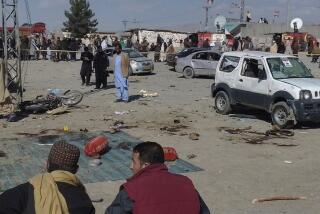Suicide bomber kills 3 in Afghanistan
- Share via
KABUL, Afghanistan — Amid sharply heightened security in advance of a major international conference, a suicide bomber Sunday killed at least three people and injured dozens on Kabul’s eastern edge, Afghan officials said.
The bombing came two days before a donor countries’ gathering, expected to be the largest of its kind to take place in Afghanistan since the 1970s. The conference was to bring together senior diplomats and officials from at least 60 nations, including Secretary of State Hillary Clinton.
Sensitive issues on the agenda include efforts to woo Taliban foot soldiers away from the battlefield, and the disbursement of foreign aid by Afghan government ministries, some of which are honeycombed with corruption.
The target of Sunday’s bombing in the district of Macroyan, which took place close to a large hospital, was unclear. Western military officials said there was no military convoy or security checkpoint in the immediate vicinity of the bombing.
It is not unusual for suicide attackers to make their way into the city and seek out targets of opportunity, such as Western convoys. One such attack in May in Kabul killed several high-ranking military officers from the United States and Canada.
The Taliban targeted the last large-scale political gathering held in Kabul, a “peace jirga” convened in June by the government of President Hamid Karzai, which brought together tribal leaders and other domestic dignitaries. Insurgents fired rockets at the conference venue while Karzai was speaking.
Taliban fighters were expected to make some kind of move against Tuesday’s conference as well, which was much more high-profile than June’s meeting. Afghan and Western officials Saturday reported they had mounted a raid the previous night that netted an insurgent commander suspected of masterminding a planned attack.
Sunday’s bombing in Kabul came hours after a brazen jailbreak in western Afghanistan. Authorities in Farah province said attackers apparently managed to smuggle an explosive device into the prison, which housed both captured insurgents and common criminals.
Twenty-three prisoners escaped in the wake of the bombing, which destroyed the prison’s outer gate shortly after 2 a.m., said Younus Rasouli, Farah’s deputy governor. Eleven remained at large after eight of the escapees were captured and another four were wounded in a gunfight with security forces. One of the prisoners died later of his injuries, together with a prison guard.
The Taliban claimed responsibility for the jailbreak, which echoed previous attacks on prisons, including a spectacular attack in June 2008 in Kandahar that freed hundreds of insurgents.
Taliban spokesman Qari Yousaf Ahmadi said nearly 300 prisoners had escaped in Sunday’s jailbreak, but highly exaggerated claims by the movement are not unusual.
The Western military Sunday also reported the death of an American service member in a roadside bombing in southern Afghanistan.
June was the deadliest month of the war to date for NATO forces, with more than 100 troops killed, and July appeared on track to equal or surpass that toll. Improvised explosive devices, or IEDs, account for the majority of Western battlefield casualties, and most of those deaths and injuries take place in the volatile south.
More to Read
Sign up for Essential California
The most important California stories and recommendations in your inbox every morning.
You may occasionally receive promotional content from the Los Angeles Times.













